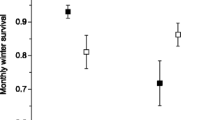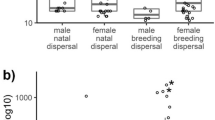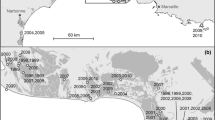Abstract
In most birds, natal dispersal is female-biased, but the selective pressures leading to this pattern have rarely been explored with comprehensive data on lifetime reproductive success. In territorial birds, the benefit of philopatry should be higher for males than for females when males establish territories for which knowledge about the local environment is important. As females may use male characteristics for mate choice, and hence indirectly for territory choice, the benefit from the direct knowledge of the local environment may be lower for females than males. We tested this hypothesis using data from a long-term study of group living corvids, the Siberian jays (Perisoreus infaustus). In this species, the socially dominant offspring delay dispersal while the sub-dominant offspring leave the family group directly after reaching independence. Our results show that natal dispersal distance (a proxy for local knowledge) was related to sex and dispersal timing (a proxy for “quality”): Females and early dispersers traveled further on average than males and delayed dispersers. Furthermore, dispersal distance and timing were negatively related to the number of recruits produced over an individual’s lifetime in males, but not in females. Hence, the results support the hypothesis that the female-biased natal dispersal found in this and other bird species may come about through higher lifetime reproductive success of philopatric males than females.




Similar content being viewed by others
References
Alatalo RV, Lundberg A, Glynn C (1986) Female pied flycatchers choose territory quality and not male characteristics. Nature 323:152–153
Andersson M (1994) Sexual selection. Princeton University Press, Princeton
Bart J, Earnst SL (1999) Relative importance of male and territory quality in pairing success of male rock ptarmigan (Lagopus mutus). Behav Ecol Sociobiol 45:335–359
Bélichon S, Clobert J, Massot M (1996) Are there differences in fitness components between philopatric and dispersing individuals? Acta Oecol 17:503–517
Bensch S, Hasselquist D (1991) Territory infidelity in the polygynous great reed warbler Acrocephalus arundinaceus: the effect of variation in territory attractiveness. J Anim Ecol 60:857–871
Bensch S, Hasselquist D, Nielsen B, Hansson B (1998) Higher fitness for philopatric than for immigrant males in a semi-isolated population of great reed warblers. Evolution 52:877–883
Blomgren A (1964) Lavskrika. Bonniers, Stockholm
Clarke AL, Sæther B-E, Røskraft E (1997) Sex bias in avian dispersal: a reappraisal. Oikos 79:429–438
Clobert J, Danchin E, Dhondt AA, Nichols JD (2001) Dispersal. Oxford University Press, Oxford
Cox DR (1972) Regression models and life tables. Biometrics 39:67–77
Cramp S, Perrins CM (eds) (1993) The birds of the western Palaearctic. Vol. VII. Oxford University Press, Oxford
Dias PC, Blondel J (1996) Local specialization and mal-adaptation in the Mediterranean blue tit (Parus caeruleus). Oecologia 107:79–86
Dobson FS (1982) Competition for mates and predominant juvenile dispersal in mammals. Anim Behav 30:1183–1192
Doligez B, Pärt T (2008) Estimating fitness consequences of dispersal: a road to ‘know-where’? Non-random dispersal and the underestimation of dispersers' fitness. J Anim Ecol 77:1199–1211
Ekman J, Sklepkovych B, Tegelström H (1994) Offspring retention in the Siberian jay (Perisoreus infaustus)—the prolonged brood care hypothesis. Behav Ecol 5:245–253
Ekman J, Bylin A, Tegelström H (1999) Increased lifetime reproductive success for Siberian jay (Perisoreus infaustus) males with delayed dispersal. Proc R Soc Lond B Biol Sci 266:911–915
Ekman J, Eggers S, Griesser M, Tegelström H (2001) Queuing for preferred territories: delayed dispersal of Siberian jays. J Anim Ecol 70:317–324
Ekman J, Eggers S, Griesser M (2002) Fighting to stay: the role of sibling rivalry for delayed dispersal. Anim Behav 64:453–459
Emlen ST, Oring LW (1977) Ecology, sexual selection and the evolution of mating systems. Science 197:215–223
Forero MG, Donázar JA, Hiraldo F (2002) Causes and fitness consequences of natal dispersal in a population of Black Kites. Ecology 83:858–872
Forslund P, Pärt T (1995) Age and reproduction in birds—hypotheses and tests. Trends Ecol Evol 10:374–378
Fridolfsson AK, Ellegren H (1999) A simple and universal method for molecular sexing of non-ratite birds. J Avian Biol 30:116–121
Greenwood PJ (1980) Mating systems, philopatry and dispersal in birds and mammals. Anim Behav 28:1140–1162
Greenwood PJ, Harvey PH (1982) The natal and breeding dispersal of birds. Annu Rev Ecol Syst 13:1–21
Griesser M, Nystrand M, Ekman J (2006) Reduced mortality selects for family cohesion in a social species. Proc R Soc B 273:1881–1886
Hanski I, Gilpin ME (1997) Metapopulation biology: ecology, genetics and evolution. Academic, London
Hansson B, Bensch S, Hasselquist D (2004) Lifetime fitness of short- and long-distance dispersing great reed warblers. Evolution 58:2546–2557
Hinde RA (1956) The biological significance of the territories in birds. Ibis 98:340–369
Ingvarsson PK (2001) Restoration of genetic variation lost—the genetic rescue hypothesis. Trends Ecol Evol 16:62–63
Jaari S, Li MH, Merilä J (2009) A first-generation microsatellite-based genetic linkage map of the Siberian jay (Perisoreus infaustus): insights into avian genome evolution. BMC Genomics 10:1. doi:10.1186/1471-2164-10-1
Jaari S, Välimäki K, Merilä J (2008) Isolation and characterization of 100 polymorphic microsatellite loci for the Siberian jay (Perisoreus infaustus). Mol Ecol Res 8:1469–1474
Johnson ML, Gaines MS (1990) Evolution of dispersal: theoretical models and empirical tests using birds and mammals. Annu Rev Ecol Syst 21:449–480
Kalinowski ST, Taper ML, Marshall TC (2007) Revising how the computer program CERVUS accommodates genotyping error increases success in paternity assignment. Mol Ecol 16:1099–1106
Keller LF, Waller DM (2002) Inbreeding effects in wild populations. Trends Ecol Evol 17:230–241
Koenig WD, VanVuren D, Hooge PN (1996) Detectability, philopatry, and the distribution of dispersal distances in vertebrates. Trends Ecol Evol 11:514–517
Lehmann L, Perrin N (2003) Inbreeding avoidance through kin recognition: choosy females boost male dispersal. Am Nat 162:638–652
Lenormand T (2002) Gene flow and the limits to natural selection. Trends Ecol Evol 17:183–189
Lillandt B (1993) Lavskrikans (Perisoreus infaustus) populationsutveckling inom ett sammanhängande skogsområde i Sydösterbotten 1974–1992. M.Sc. Thesis, University of Helsinki
Lillandt B, Bensch S, von Schantz T (2001) Parentage determination in kin-structured populations: microsatellite analyses in the Siberian Jay Perisoreus infaustus during a 25-year population study. Avian Sci 1:3–14
Lillandt B, Bensch S, Hansson B, Wennerberg L, Von Schantz T (2002) Isolation and cross-species amplification of microsatellite loci in the Siberian Jay (Perisoreus infaustus). Hereditas 137:157–160
Lillandt BG, Bensch S, von Schantz T (2003) Family structure in the Siberian Jay as revealed by microsatellite analyses. Condor 105:505–514
Madsen T, Shine R, Olsson M, Wittzell H (1999) Conservation biology—restoration of an inbred adder population. Nature 402:34–35
Mauck RA, Huntington CE, Grubb TC (2004) Age-specific reproductive success: evidence for the selection hypothesis. Evolution 58:880–885
Møller AP, Alatalo RV (1999) Good-genes effects in sexual selection. Proc R Soc Lond B Biol Sci 266:85–91
Nilsson J-Å (1989) Causes and consequences of natal dispersal in the Marsh Tit, Parus palustris. J Anim Ecol 58:619–636
Oring LW, Lank DB (1982) Sexual selection, arrival times, philopatry and site fidelity in the polyandrous spotted sandpiper. Behav Ecol Sociobiol 10:185–191
Perrin N, Mazalov V (2000) Local competition, inbreeding, and the evolution of sex-biased dispersal. Am Nat 155:116–127
Pinheiro JC, Bates DM (2000) Mixed-effects models in S and S-PLUS. Springer, New York
Piper WH, Walcott C, Mager JN, Spilker FJ (2008) Nestsite selection by male loons leads to sex-biased site familiarity. J Anim Ecol 77:205–210
Price TD (1984) Sexual selection on body size, territory and plumage variables in a population of Darwin finches. Evolution 38:327–341
Pusey AE (1987) Sex-biased dispersal and inbreeding avoidance in birds and mammals. Trends Ecol Evol 2:295–299
Pusey AE, Wolf M (1996) Inbreeding avoidance in animals. Trends Ecol Evol 11:201–206
Pärt T (1990) Natal dispersal in the collared flycatcher: possible causes and reproductive consequences. Ornis Scand 21:83–88
Pärt T (1991) Philopatry pays: a comparison between collared flycatchers sisters. Am Nat 138:790–796
Pärt T (1994) Male philopatry confers a mating advantage in the migratory collared flycatcher, Ficedula albicollis. Anim Behav 48:401–409
Pärt T (1995) The importance of local familiarity and search costs for age- and sex-biased philopatry in the collared flycatcher. Anim Behav 49:1029–1038
R Development Core Team (2007) R: a language and environment for statistical computing. R Foundation for Statistical Computing, Vienna, Austria
Reid JM, Bignal EM, Bignal S, McCracken DI, Monaghan P (2003) Age-specific reproductive performance in red-billed choughs Pyrrhocorax pyrrhocorax: patterns and processes in a natural population. J Anim Ecol 72:765–776
Safran RJ (2007) Settlement patterns of female barn swallows Hirundo rustica across different group sizes: access to colorful males or favored nests? Behav Ecol Sociobiol 61:1359–1368
Slagsvold T (1986) Nest site settlement by the pied flycatcher—does the female choose her mate for the quality of his house or himself. Ornis Scand 17:210–220
Slatkin M (1985) Gene flow in natural populations. Annu Rev Ecol Syst 16:393–430
van Noordwijk AJ (1984) Problems in the analysis of dispersal and a critique on its ‘heritability’ in the Great Tit. J Anim Ecol 53:533–544
van Noordwijk AJ, DeJong G (1986) Acquisition and allocation of resources: their influence on variation in life history tactics. Am Nat 128:137–142
Verhulst S, van Eck HM (1996) Gene flow and immigration rate in an island population of great tits. J Evol Biol 9:771–782
Vila C, Sundqvist AK, Flagstad O, Seddon J, Björnerfeldt S, Kojola I, Casulli A, Sand H, Wabakken P, Ellegren H (2003) Rescue of a severely bottlenecked wolf (Canis lupus) population by a single immigrant. Proc R Soc Lond B Biol Sci 270:91–97
Wheelwright NT, Mauck RA (1998) Philopatry, natal dispersal, and inbreeding avoidance in an island population of Savannah Sparrows. Ecology 79:755–767
Wheelwright NT, Schultz CB (1994) Age and reproduction in savanna sparrows and tree swallows. J Anim Ecol 63:686–702
Acknowledgements
This work was financially supported by the Academy of Finland (to P.G. and to J.M.), the University of Helsinki (to J.M.), Maj & Tor Nessling Foundation (to J.M.), and Kone Foundation (to P.G.). Bo-Göran Lillandt managed the fieldwork for many years and put the data at our disposal. He and many others also collected the data. Hanna Kokko, John Loehr, Amber Teacher, and Mark Hauber made helpful comments on the manuscript.
Ethical notes
Fieldwork for this study has been carried out under the necessary licenses and was in accordance with the relevant animal welfare regulations. The authors declare that they have no conflict of interest.
Author information
Authors and Affiliations
Corresponding author
Additional information
Communicated by M. Hauber
Rights and permissions
About this article
Cite this article
Gienapp, P., Merilä, J. Sex-specific fitness consequences of dispersal in Siberian jays. Behav Ecol Sociobiol 65, 131–140 (2011). https://doi.org/10.1007/s00265-010-1017-x
Received:
Revised:
Accepted:
Published:
Issue Date:
DOI: https://doi.org/10.1007/s00265-010-1017-x




